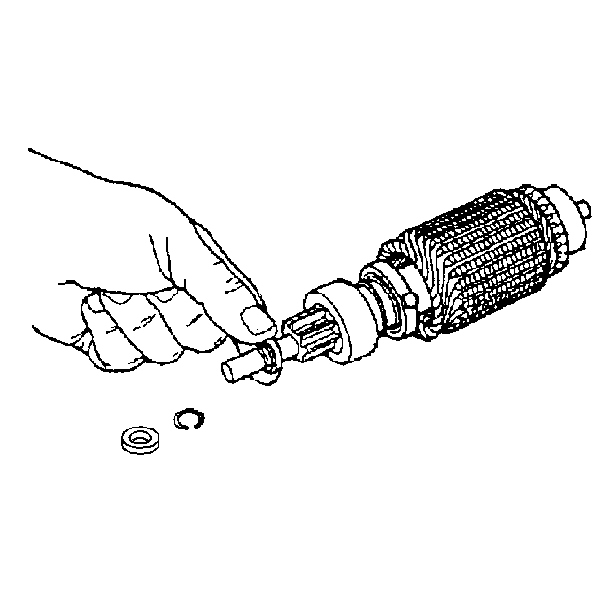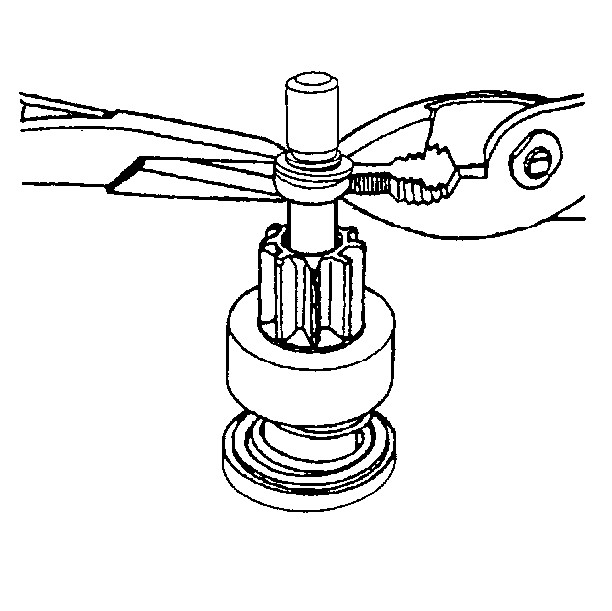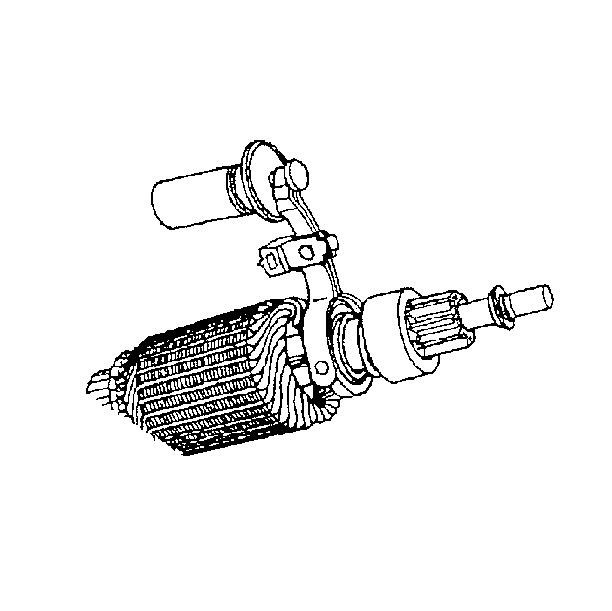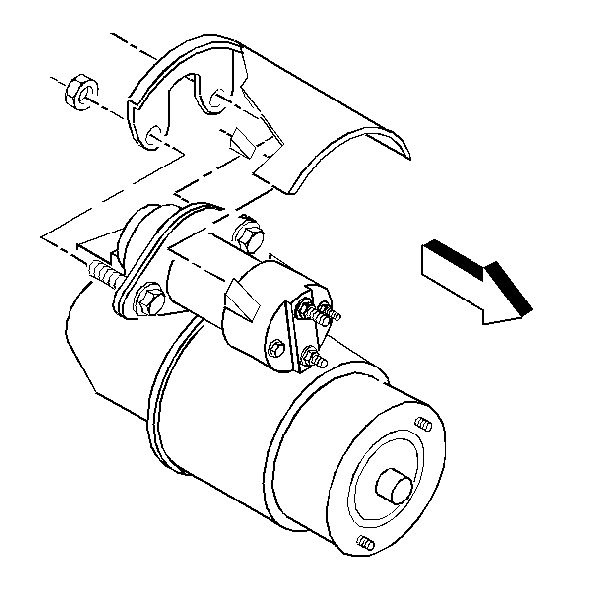Assembly Procedure
- Clean, then lubricate the armature shaft area that will be under
the drive assembly.
Use a suitable starter lubricant.
- Install the drive assembly onto the armature shaft.
- Install the drive pinion stop collar.
The flat side goes toward the drive pinion.
- Install a new retaining ring onto the armature shaft.
Slide the ring down the shaft, until the ring seats in the shaft groove.

- Install the thrust collar onto the shaft
with the small flange toward the retaining ring.

- Using two pair of pliers, push the pinion
stop collar and the thrust collar together.
Snap the stop collar onto the retaining ring.
- Inspect the drive end bushing (SD-210).
| • | If no lubrication can be seen, lubricate the bushing. |
| • | Avoid excessive grease. |
| • | If the bushing is damaged, install a new drive end frame. |
- Inspect the drive end bearing (SD-260).
| • | If no lubrication can be seen, do not lubricate the bearing. |
| • | Install a new bearing using a suitable driver and a hammer. |
| • | Drive the bearing in until the bearing is recessed 1.6 mm
(0.06 in.) into the housing. |
| • | The new bearing is pre-lubricated, do not use additional lubricant. |

- Attach the shift lever to the drive assembly.
Spread the drive lever arms slightly, in order to snap the drive lever
buttons on the drive collar, as shown.
- Attach the plunger to the lever.
- Install the armature shaft into the drive end bearing, while sliding
the shift lever retainer into the slot on the drive end housing.
- Slide the return spring onto the plunger.
- Install the plug.
- Install the starter solenoid and clamp onto the drive end frame.
- Align the "M" terminal with the field connector.
- Install the attaching screw.
- Install the solenoid retaining clamp screws.
Tighten
Tighten the screws to 11 N·m (95 lb in).
Notice: Use the correct fastener in the correct location. Replacement fasteners
must be the correct part number for that application. Fasteners requiring
replacement or fasteners requiring the use of thread locking compound or sealant
are identified in the service procedure. Do not use paints, lubricants, or
corrosion inhibitors on fasteners or fastener joint surfaces unless specified.
These coatings affect fastener torque and joint clamping force and may damage
the fastener. Use the correct tightening sequence and specifications when
installing fasteners in order to avoid damage to parts and systems.
Frame and Field Assembly
- Clean the contact surfaces of the brushes with a clean, dry, soft
cloth.
- Clean the commutator with a clean, dry, soft cloth.
- Push the brushes into the brush holders.
- Hold the brushes in place while installing the armature.
The armature brake washer can be used to bottom all four brushes in
their holders while installing the armature.
- Release the brushes onto the armature commutator.
| • | Make sure all four brushes move freely within the holders. |
| • | Make sure all of the brushes contact the commutator. |
- Install the brake washer to the end of the armature assembly.
- Align the scribe mark on the field frame with the scribe mark
on the drive end frame.
- Install the drain tube to the field frame, if removed.
- Install the end frame to the field frame.
| • | If the end frame bearing has no lubrication or looks damaged,
install a new end frame bearing. |
| • | Draw the old bearing out, using a suitable puller. |
| • | Recess the new bearing 2 mm (0.08 in.) into the
housing. |
| • | The new bearing is pre-lubricated. Do not add lubricant. |
- Install the identification tag over the hole in the end frame
with the fluted end around the bearing well.
- Install the through-bolts in their original locations.
Tighten
Tighten the through bolts to 8.5 N·m (75 lb in.).
Notice: Use the correct fastener in the correct location. Replacement fasteners
must be the correct part number for that application. Fasteners requiring
replacement or fasteners requiring the use of thread locking compound or sealant
are identified in the service procedure. Do not use paints, lubricants, or
corrosion inhibitors on fasteners or fastener joint surfaces unless specified.
These coatings affect fastener torque and joint clamping force and may damage
the fastener. Use the correct tightening sequence and specifications when
installing fasteners in order to avoid damage to parts and systems.
- Install the motor field lead over the motor terminal on the solenoid.
- Install the field lead attaching nut.
Tighten
Tighten the nut to 11 N·m (95 lb in.).

- Install the solenoid shield onto the protruding
ends of the solenoid attaching screws.
- Install the shield attaching nuts.
Tighten
Tighten the nuts to 8 N·m (70 lb in.).




